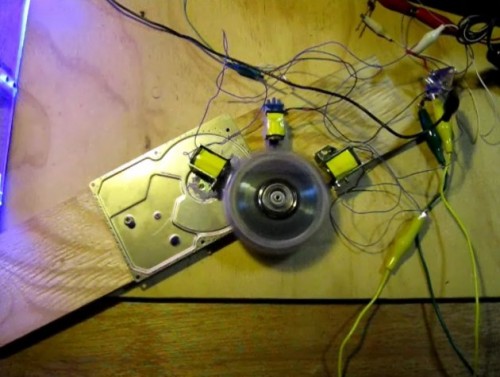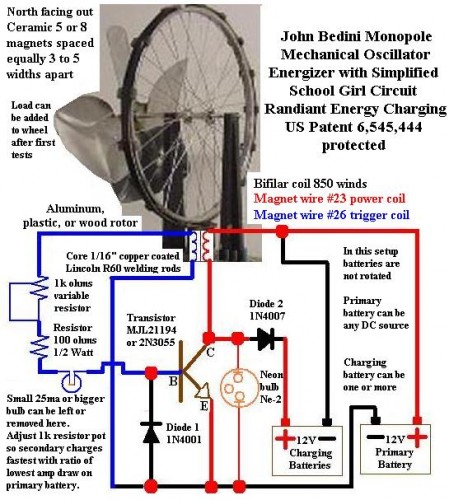How to desulfate lead acid batteries for free
Desulfate Lead Acid Batteries
You can restore lead acid batteries for free. With a few junk parts you can salvage from an old printer and a dead computer hard drive you can make a free battery desulfator which will return even the most sulfated battery to usable condition.
This battery desulfator is based on the well known Bedini Simplified School Girl Motor circuit. The Bedini SSG uses a simple coil, ceramic magnets on a free spinning wheel, a transistor, two diodes and a resistor. Thats all you need to make a radiant energy battery restorer. The radiant energy spoken of here is also known as back emf. This is the pulse of electricity you get when the field from an energized coil collapses when the power is removed. We use this back emf to restore batteries. For full details on the Bedini SSG radiant energy device, please see How to make an SSG
Find an old laser printer or a dot matrix printer. These have solenoids in them. Usually they have between one to three inside. These will be used for the coils. A dead hard drive can be used for its motor bearings and hard drive plates. You will also need about 6 ceramic magnets. Simple, cheap weak magents work best for this project. Do not go out and buy neo magnets because they will not work. This is not a generator. You do not want to generate electricity, just keep the wheel spinning around. The radiant energy does the work for you.
 Make a battery desulfator for free
Make a battery desulfator for free
Because you will be using solenoids, you will need two of them. Three would be better, if you have them, to make the machine more powerful. One coil will be used as the trigger coil. The other coil will be the power coil. If you use two power coils, they should be the same size and dimensions.

Bedini SSG radiant energy charger
The schematic above is from the Bedini Monopole 3 Yahoo groups page. You can click on the image for a larger size view. A new window will pop up with the image.
The wheel can be any non magnetic wheel. The bearings must be free spinning and loose. The wheel should have some mass to act as a flywheel. In our case, a hard drive motor was used with the hard drive plates used for a flywheel. You can replace the two coils in the schematic with your solenoids from a printer.
For smaller coils like these solenoids, use a 680 ohm resistor instead of the 1k ohm listed. Any power transistor will work, but the one listed performs better.
When you have the circuitry assembled, you will need to adjust the coils for the best performance. This is not a self starting motor, so you will need to give the wheel a spin. Do not dispair if it does not run at the first attempt. You may need to do some trouble shooting to get it to run right.
Make sure the coils are not too close to the magnets. Remember, this is not a generator, the operation of this motor is a bit different than standard generators and motors. We simply want to get a pulse to be generated in the trigger coil and the power coils will repel the magnet, causing the wheel to keep spinning. You may need to keep adjusting the coil and magnet spacing a bit in order to get the best performance.
Make sure that your coils are all in the same direction. The direction of the windings should be the same.
When you get the motor up and running, then the dead, sulfated battery will start to show a charge. This is not conventional charging. A conventional charger will not charge a battery that is too badly sulfated and has too low a voltage. Most chargers will not even recognize a battery with too low a voltage.
It may take some time to restore your battery, depending on how badly it was sulfated and how large the battery is. Most batteries will also require a series of charge and discharge cycles to get them up to their top capacity.
Charge the battery until it stops increasing in voltage. One example was a battery which stopped taking a charge at 9.3 volts. The radiant charger was disconnected from the battery and a 15 watt 12 volt lamp was used to run it down a little bit. Just let it run for a few minutes to drain the battery some. At this low voltage, 5 minutes is fine. Then put the battery back on the radiant charger again until it stops increasing in voltage. Our example battery was at about 10 volts this time. Then run the light a little bit longer to discharge the battery some. A few repeated cycles will show an ever increasing gain in the battery. Eventually the battery will be restored to full capacity.
You can see a video of this little charger in action here:
Desulfate lead acid batteries Free
Link will open up to Youtube in a new window
Note: only sulfated lead acid batteries can be restored with this method. If the battery is physically damaged or the plates have deteriorated too much and the material has fallen off the plates, then the battery may be beyond repair.
Feel free to ask any questions or get help with your project on our Support Forum.
About the Author
| Troy Reid |



